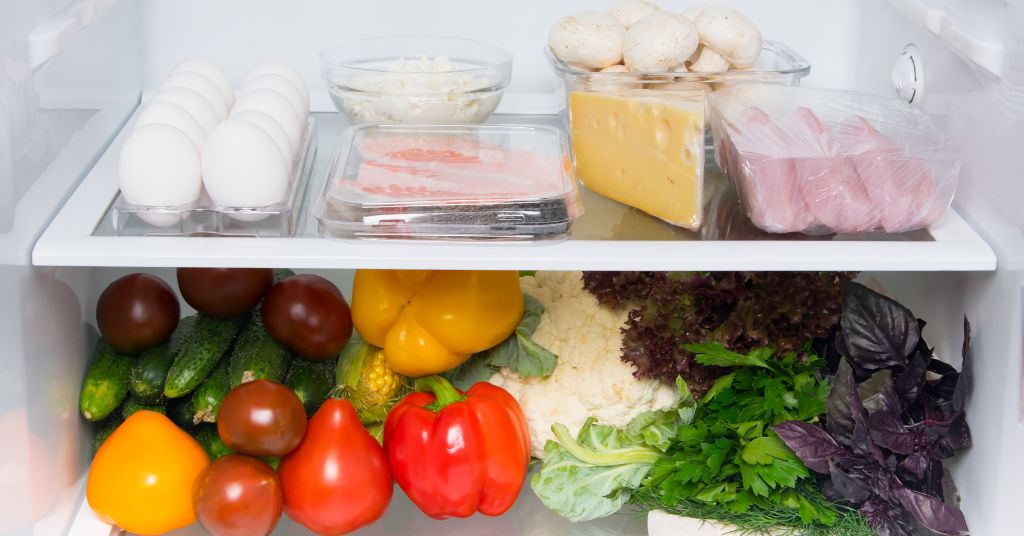There’s never a bad time to give your space a deep clean! It’ll help you feel more organized and create a healthier environment, especially in the kitchen. In this article, we’ll walk you through cleaning and organizing your fridge, so you can cut down on food waste, save time, and enjoy the refreshing sight of a clutter-free fridge every time you open it.

Cleaning Your Fridge
When we think of spring cleaning, the fridge often gets overlooked. After all, the door is usually closed, so it’s easy to forget about! But it’s a key part of your kitchen and surprisingly simple to clean. Here’s a quick step-by-step guide to get your fridge looking fresh.
- Start by tossing any spoiled or expired food.
- Empty the entire fridge, placing all food items on a counter or table while you clean.
- Remove all detachable parts, like shelves and drawers.
- Wash the removable parts by hand with warm, soapy water. Use a non-scratch sponge to avoid damage. Just be careful not to run hot water over cold glass shelves, as they could crack.
For best results, we recommend cleaning and sanitizing your fridge before you load it back up. Make sure to take a moment to wipe down any sticky or dirty containers and the doors before you put your food back in. And that’s it, you’ve got yourself a clean fridge!
Cleaning physically removes most germs, dirt, and impurities. Wipe down the inside of your refrigerator with a solution of hot water and vinegar put in a spray bottle. A solution of hot, soapy water can also work, but vinegar is food-safe and has no soapy film. We find that a sponge and /or microfiber cloth works best. Alternatively, you can use a gentle cleaner if you prefer. We suggest you try our Simply Done brand cleaners.
Sanitizing reduces the number of germs on objects and surfaces to levels considered safe. Using a weaker bleach solution to sanitize is beneficial, just mix a simple solution of one tablespoon of liquid bleach with one gallon of water.
Try Simply Done Brand products - Great Quality at a Great Price!
Organizing Your Fridge

There’s no one-size-fits-all approach to organizing your fridge, but there are some basic guidelines to follow based on the temperature of different areas and the types of food you store.
In general, you have three shelves/areas, along with drawers:
- Bottom shelf: Best for more sensitive items like meat or fish.
- Middle shelf: Ideal for uncovered produce, such as berries.
- Top shelf: This part is usually warmer, so avoid storing fresh meat here. It’s a good spot for items you need to eat soon, like takeout or leftovers.
- Drawers: The best place for your produce.
A good rule of thumb is to keep the most time-sensitive items front and center to help reduce food waste. Speaking of food waste, many fruits release gas that speeds up the ripening of nearby produce—sometimes too quickly—so it’s best to separate fruits and veggies.
For this, you can use clear bins or dividers to easily see what you have or try a Lazy Susan (rotating tray) for better access to your items.
Also, avoid storing perishable items like milk in the fridge doors. While it’s convenient, the temperature in the door fluctuates and can cause item to spoil faster. It’s safer to store these items in the main part of the fridge, where the temperature remains more stable.
Finishing Up
To keep your fridge smelling fresh and clean, try deodorizing it with baking soda. Simply place an open box inside to help absorb any unwanted odors. Be sure to replace it every three months for maximum effectiveness.
And there you have it, a clean, organized fridge! Whether for spring cleaning or just a seasonal refresh, you’ll love the difference a tidy fridge makes.
Shopping List:
- Simply Done Sponges/Cloths
- Simply Done Gloves
- Simply Done Trash Bags
- Simply Done Dish Soap
- Simply Done Disinfecting Wipes
- Simply Done Cleaning Vinegar
- Simply Done Bleach
- Stater Bros. Baking Soda






